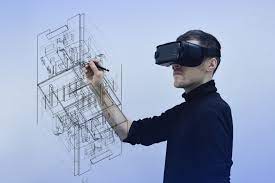The Potential of Virtual Reality for Architecture and Design: Creating Immersive and Interactive Spaces
Virtual reality (VR) technology has come a long way since its inception in the 1980s. With the rapid advancements in hardware and software, VR has become more accessible and affordable, making it an increasingly popular tool in various fields. One area that has seen significant growth in the use of VR is architecture and design. Architects and designers are leveraging the potential of VR to create immersive and interactive spaces that enable clients to experience their designs in a more realistic and engaging way.
VR technology allows architects and designers to create digital models of their designs and experience them in a fully immersive and interactive way. This is done by wearing a VR headset that provides a 360-degree view of the digital model. The headset is equipped with motion sensors that track the movement of the user’s head, allowing them to look around the virtual space as if they were actually there. Additionally, the user can interact with the virtual environment through hand-held controllers or other input devices, allowing them to manipulate objects and navigate the space.
One of the primary advantages of using VR in architecture and design is the ability to create realistic and immersive environments that can be experienced before the construction phase. This allows architects and designers to visualize their designs in a more comprehensive and accurate way, and to make any necessary adjustments before construction begins. It also provides clients with a more detailed and engaging understanding of the design, which can help to build trust and confidence in the project.
VR technology also allows architects and designers to experiment with different design options and configurations more easily. By creating digital models of a design, it is possible to test out various design options and configurations without having to physically build and demolish them. This can save time and money, as well as reduce waste and the environmental impact of construction.
Another advantage of VR in architecture and design is the ability to create interactive and engaging experiences for clients. By using VR, architects and designers can create virtual tours of their designs, allowing clients to explore the space and experience it in a more immersive and interactive way. This can help to communicate the design vision more effectively and provide clients with a deeper understanding of the design.

VR technology is also useful for collaboration and communication between architects, designers, and clients. By creating digital models of a design, it is possible to share and collaborate on the design with others, regardless of their physical location. This can help to streamline the design process and improve communication and collaboration between all parties involved in the project.
Despite its many advantages, VR technology is not without its challenges. One of the main challenges is the high cost of VR hardware and software. While the cost of VR technology has decreased significantly in recent years, it is still relatively expensive and may not be accessible to all architects and designers. Additionally, there is a learning curve associated with using VR technology, which may require additional training and resources.
Another challenge is the limited availability of VR content and applications specifically designed for architecture and design. While there are many VR applications available, they may not be tailored to the specific needs of architects and designers. This can limit the effectiveness and usefulness of VR technology in these fields.
Despite these challenges, the potential of VR technology for architecture and design is significant. As the technology continues to evolve and become more accessible, it is likely that more architects and designers will begin to incorporate VR into their design processes. This will not only help to improve the quality and efficiency of the design process but also provide clients with a more engaging and immersive experience of their designs.
Conclusion
Virtual reality technology has significant potential for architecture and design. By creating immersive and interactive environments, VR technology allows architects and designers to visualize their designs more comprehensively and accurately, experiment with different design options more easily, and provide clients with a more engaging and interactive experience of their designs. Despite its challenges, the use of VR technology in architecture and design is on the rise, and it is expected to become increasingly popular in the coming years.
One of the key benefits of VR technology for architecture and design is the ability to create a fully immersive experience for the client. With the help of VR, clients can experience the design in a much more detailed and engaging way than they would with traditional 2D renderings or blueprints. This can help them to better understand the design and to make more informed decisions about its features and functionality. Additionally, the ability to experience a design in VR can help to identify potential issues or areas for improvement before construction begins, saving time and money.

Another advantage of VR technology in architecture and design is its ability to enhance communication and collaboration. By creating digital models of a design, architects and designers can share their work with clients and colleagues in real-time, regardless of their location. This can help to streamline the design process and reduce the need for costly and time-consuming physical meetings. Additionally, the ability to interact with the virtual model in real-time can facilitate faster decision-making and problem-solving.
The potential of VR technology in architecture and design is not limited to the design process itself. VR can also be used to create engaging and interactive experiences for visitors to a completed building or space. For example, museums and exhibitions can use VR technology to provide visitors with immersive experiences that bring exhibits to life. Similarly, retail stores can use VR to create virtual shopping experiences that allow customers to browse and purchase products in a virtual environment.
Despite the many benefits of VR technology in architecture and design, there are still some challenges that need to be overcome. One of the main challenges is the need for high-quality digital models. Creating a digital model that accurately represents the design can be time-consuming and requires a high level of technical expertise. Additionally, the cost of creating these models can be prohibitive for smaller architecture and design firms.
Another challenge is the need for specialized hardware and software. While VR technology has become more accessible in recent years, it still requires a significant investment in hardware and software. This can be a barrier to entry for some architects and designers who may not have the resources to invest in VR technology.
Despite these challenges, the potential of VR technology for architecture and design is significant. As the technology continues to evolve and become more accessible, it is likely that more architects and designers will begin to incorporate VR into their design processes. This will not only help to improve the quality and efficiency of the design process but also provide clients with a more engaging and immersive experience of their designs.
Virtual reality technology has the potential to revolutionize the field of architecture and design. By creating immersive and interactive environments, VR technology allows architects and designers to visualize their designs more comprehensively and accurately, experiment with different design options more easily, and provide clients with a more engaging and interactive experience of their designs. While there are still some challenges to overcome, the benefits of VR technology for architecture and design are significant, and it is likely that more architects and designers will begin to incorporate VR into their design processes in the coming years.
















